Susan is one of the most talented, innovative, generous designers I’ve ever met. It’s been our honor to have her teach at many of our Seasonal Floral Design Workshops, and student feedback was overwhelming each time. If you ever have a chance to take a class with Susan, don’t pass it up. Her positivity and creativity are infectious, and she has inspired so many designers to think outside the box and try new things. Susan has a big year ahead of her, with teaching opportunities across the world and the release of her spectacular new book, The Art of Wearable Flowers, so I’m thrilled to have the chance to talk with her about her journey.
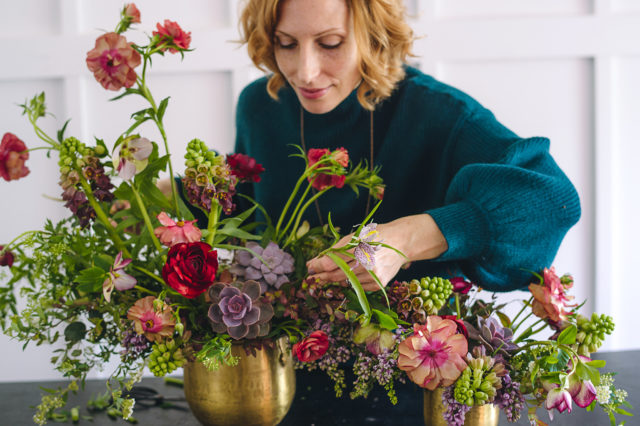 Erin: Susan, thanks so much for taking time to share your story with Floret readers. For those not familiar with your work, can you share an overview of your story?
Erin: Susan, thanks so much for taking time to share your story with Floret readers. For those not familiar with your work, can you share an overview of your story?
Susan: Thank you for having me! I found this work more than 15 years ago when a friend asked me to do her wedding flowers. I had a hobby making jewelry at the time, and my friend had initially asked me to make jewelry for herself and her bridal party. I added on the floral challenge but honestly felt pretty neutral about it. I had no idea that I’d connect with it so immediately and strongly. It was a real time-stopping moment—I realized quite viscerally during the work that I was meant to be a florist. I’d always been vaguely artistic but had never felt very good at any one discipline. I decided to listen to this feeling and became obsessed. I began to gather as much information as I could. I read every book at the library, took classes at my local community college, earned certifications through the Michigan Floral Association and AIFD [American Institute of Floral Designers], freelanced for event florists, and ultimately got a job at a bustling full-service floral shop.
Those experiences taught me so much, but at a point, I realized there had to be more to this work. The design opportunities I was exposed to were limited and pretty one-note. I had connected with many inspiring people and had gathered skills, but I was really having trouble envisioning my place in this field. My curiosity and frustration led to much Internet surfing, where I finally started to find other florists out in the world creating dynamic, artful, expansive work—each with a distinct point of view.
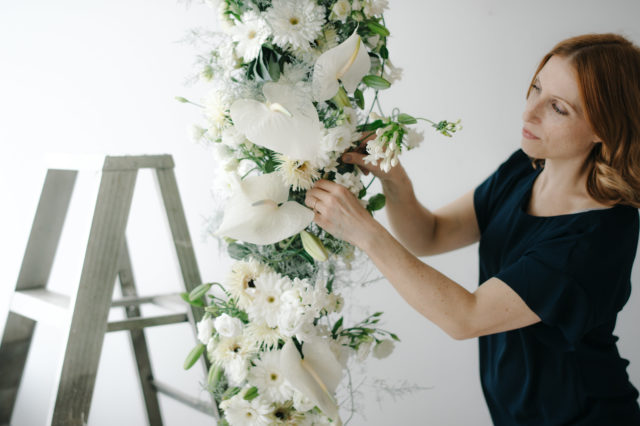 At the time, the prevailing look in the U.S. was dense, rounded, and quite formal. I did not connect with this, but unfortunately, this was what I was making each weekend! It was when I encountered Francoise Weeks’s work that it finally clicked that floral design is an art, and each designer can—and should—express their own viewpoint through it. This discovery led to others, and I expanded my circle of influence. I attended design workshops and met many more influential people—Francoise of course, but also Joseph Massie, Holly Chapple, and you, Erin! I felt encouraged to make the leap to open my own studio and make the things I wanted to see.
At the time, the prevailing look in the U.S. was dense, rounded, and quite formal. I did not connect with this, but unfortunately, this was what I was making each weekend! It was when I encountered Francoise Weeks’s work that it finally clicked that floral design is an art, and each designer can—and should—express their own viewpoint through it. This discovery led to others, and I expanded my circle of influence. I attended design workshops and met many more influential people—Francoise of course, but also Joseph Massie, Holly Chapple, and you, Erin! I felt encouraged to make the leap to open my own studio and make the things I wanted to see.
I enjoyed nearly 10 years producing weddings and events under my studio name, Passionflower. About 3 years ago, my curious nature tugged once more, and I began sharing my passion for flowers, the art of floristry, and the profession as a teacher and writer instead of a studio florist. I occasionally design for a wedding or event, but my real jam is working to identify common design challenges, break them down, and develop processes to ease them a bit. I’m driven to add my voice to the conversation—ideas on sustainable, updated, fashion-forward floral design. My online classes (www.passionflowersue.com) have allowed me to transition into this role, and I’m so grateful.
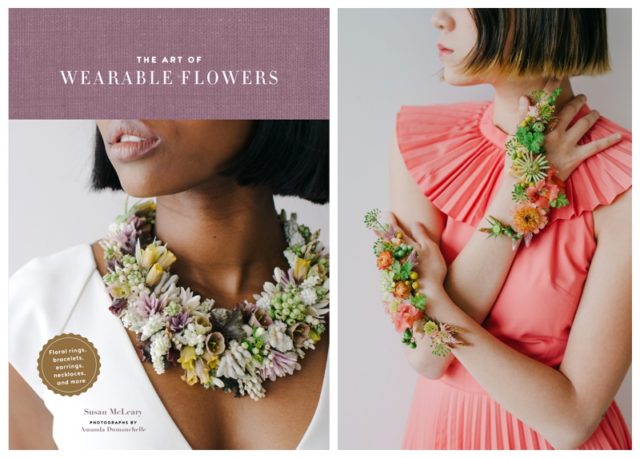 Erin: Your book, The Art of Wearable Flowers (Chronicle, March 3, 2020), hits stores this spring. I’m lucky enough to have gotten a sneak peak! Congratulations on creating a book that is gorgeous, unique, and inspiring in both the design and in the depth of projects. What prompted you to write this book?
Erin: Your book, The Art of Wearable Flowers (Chronicle, March 3, 2020), hits stores this spring. I’m lucky enough to have gotten a sneak peak! Congratulations on creating a book that is gorgeous, unique, and inspiring in both the design and in the depth of projects. What prompted you to write this book?
Susan: I’ve always dreamed of writing a book and am quite lucky that my publisher found me on Instagram! I feel like it was kismet—I deliberately worked to develop a portfolio of work that I felt was strong enough to approach a publisher with, and I had started working on a book proposal, so when I got the email, I was thrilled! It really is the first of what I hope to be many love letters to this work. It’s meant to inspire florists to make the things that fire them up, and it’s meant to excite the public, showing people a bit of what’s possible within this medium.
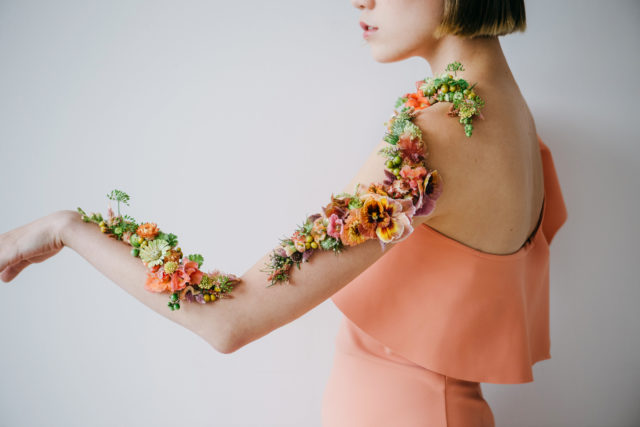 Erin: The book contains nearly 40 how-to projects. How long did it take to complete, and can you tell us a bit about the process of taking a project from the idea phase through to the final beautifully styled photo?
Erin: The book contains nearly 40 how-to projects. How long did it take to complete, and can you tell us a bit about the process of taking a project from the idea phase through to the final beautifully styled photo?
Susan: From start to finish, just under 2 years. The ideas came fairly easily, but the planning and coordination was quite a feat! I worked with the photographer on the project, Amanda Dumouchelle, to choose dates that worked for us both, reach out to models, hair and makeup people, choose—and often gather—wardrobe pieces, and, of course, choose and gather the flowers, plants, and foliages. I’m a bit tightly wound, so I had to learn to accept that not every component of a given design will always materialize as planned. I had to harness my powers of pivot and flexibility, and I also had to become a better planner. Each step-by-step project had to be made to completion ahead of time, and then created a second time, step by step, in front of the camera. It was quite an undertaking!
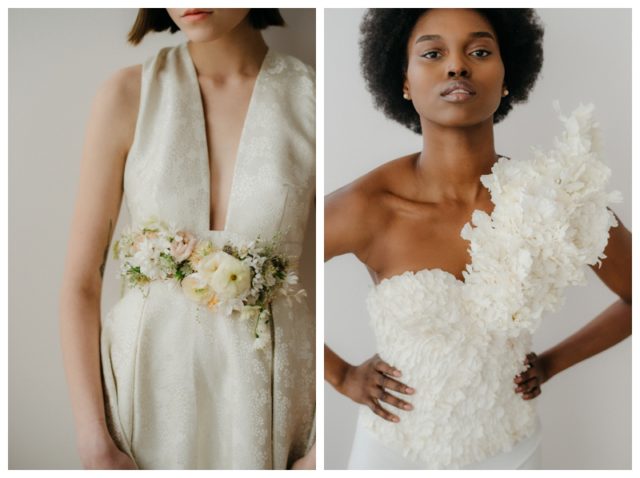 Erin: In the introduction you write, “Through years of reading, observing others, creating, taking apart, and creating again, I’ve developed some helpful rules based on a set of principles that I use over and over again. These design rules guide my work … .” You go on to explain contrast, weight, air, and the golden ratio. Why was it important to you to include design principles and theory?
Erin: In the introduction you write, “Through years of reading, observing others, creating, taking apart, and creating again, I’ve developed some helpful rules based on a set of principles that I use over and over again. These design rules guide my work … .” You go on to explain contrast, weight, air, and the golden ratio. Why was it important to you to include design principles and theory?
Susan: This is really important to me at this stage of my work life. There’s a richness underneath floral design—design principles and art theories that, when applied, can answer placement questions and inform the choices the designer makes. These result in work with dimension, movement, depth, naturally pleasing proportion, and visual flow. I’d argue that when one has knowledge of these, the work becomes more stimulating and creatively sustaining. It becomes more than making beautiful compositions, it becomes the creation of art. I think there’s a danger of losing interest or becoming stifled without this awareness.
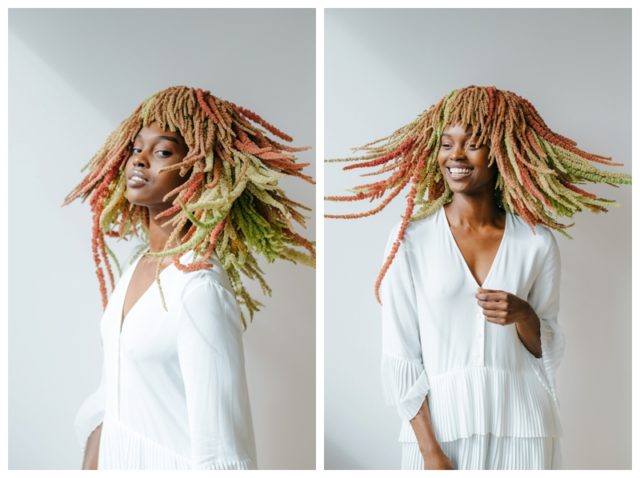 Erin: I loved what you wrote in your dedication: “Create that which you crave to see.” Can you tell us what that means to you and why it was an important enough phrase to make it into your dedication?
Erin: I loved what you wrote in your dedication: “Create that which you crave to see.” Can you tell us what that means to you and why it was an important enough phrase to make it into your dedication?
Susan: This has become my mantra! I found, in my own life, that when I try to replicate what other people are doing or when I work in reaction to a request, I make things that don’t inspire me or others. It’s only when I listen to my own creative voice that I make things that fire me up—thus leading to greater creative energy and more ideas—and also connect with other people. It’s also sort of a kick-in-the-pants mantra in my mind: If there’s something you see that needs to improve or change, then take the initiative and push a solution forward!
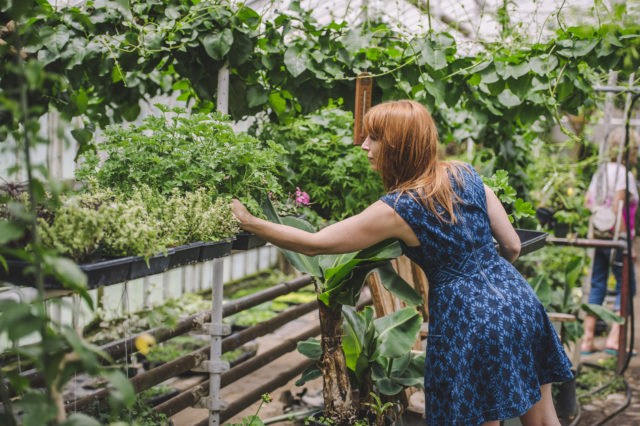 Erin: I’m curious about the sourcing process for the various flowers, succulents, and greenery used in your book? Did you use local flowers?
Erin: I’m curious about the sourcing process for the various flowers, succulents, and greenery used in your book? Did you use local flowers?
Susan: Yes, as much as possible. I live in Michigan, so the season is short, but within the season I reached for local materials first. In the growing months, I bought as much as possible from the Michigan Flower Growers’ Co-op. I also gathered from Seely Farm, Michigan Flower Farm, and the Ann Arbor Farmers Market. Many of the blooms were grown by my friend Adrianne of Marilla Field and Flora. She allowed me to pop over to her field after hours, count my own stems, and send payment online, all of which was incredibly helpful. The healthy, teeny baby succulents in the living jewelry chapter were grown by my favorite local greenhouse, Graye’s. In the cold months, I had flowers shipped to me from Florabundance in Carpinteria, California. I love the fact that they source from plenty of U.S. growers and label these selections on their website, and their quality is superb. I also grow a bit in my teeny yard and was happy to have attractive clipping options outside my front door.
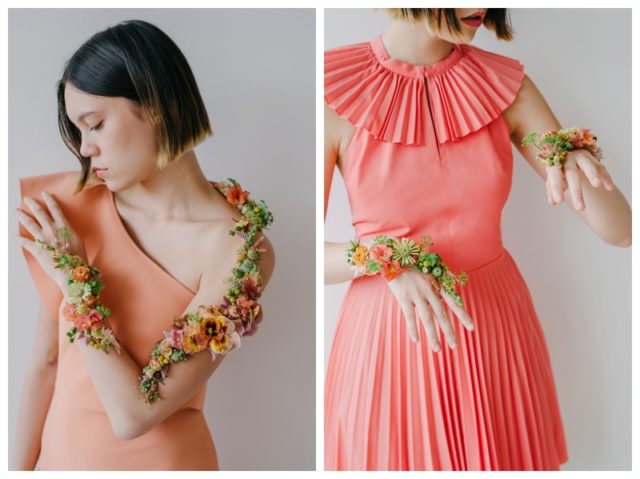 Erin: After what I’m guessing has been many years of dreaming of and working toward this book, its release is just around the corner now! What do you hope comes from the book’s venture out into the world?
Erin: After what I’m guessing has been many years of dreaming of and working toward this book, its release is just around the corner now! What do you hope comes from the book’s venture out into the world?
Susan: I hope this book cracks open the door a bit, prompting the public to take more of an interest in the art of floral design. I hope it’s well-received, showing the publishing world that floral design is indeed enjoying a renaissance. Selfishly, I hope it leads to another book project! I’d also love the opportunity to design for mass consumption media and collaborate with global brands.
Erin: I’m sure you are busy planning events and workshops for your book release. Can you tell us a bit about your approach to teaching? And do you have in-person workshops or presentations coming up?
Susan: My approach to teaching has really developed over the years. I’ve always enjoyed demystifying intricate or complicated-looking designs, and I continue to share methods that aim to do that, but I also focus on sharing the importance of curiosity, finding your specific, unique passions within the field, and streamlining processes. I hope to cultivate an enthusiasm for this work by sharing mine.
I do have quite a line-up of workshops and presentations coming up. In March, I’ll host a book release event in my hometown, Ann Arbor, Michigan. From there, I’m presenting, teaching, and participating at the Trend Summit in Vancouver. After that, a public book event in New York in conjunction with the Chapel Designers conference. In late March, I head to Holland, where I’ll be teaching at the Boerma Instituut. After that, I’m pleased to be teaching alongside Hanneke Frankema for the Mayesh International Experience workshop.
In May, I’m excited to teach a workshop at Menagerie Flower Farm, and mid-month, I head to Seoul, Korea, to teach a 3-day workshop with the wonderful Saison Fleurie. In June, I’m teaching at the New York Botanical Garden, and at the end of the month I’m giving the keynote presentation at the Slow Flowers Summit. In early July, I will teach the first of two U.S. workshops with Mayesh, in San Francisco; the other will be in October in Raleigh, North Carolina. My final stop is at the Virginia Museum of Fine Arts in October. Links to all of these events can be found on my website.
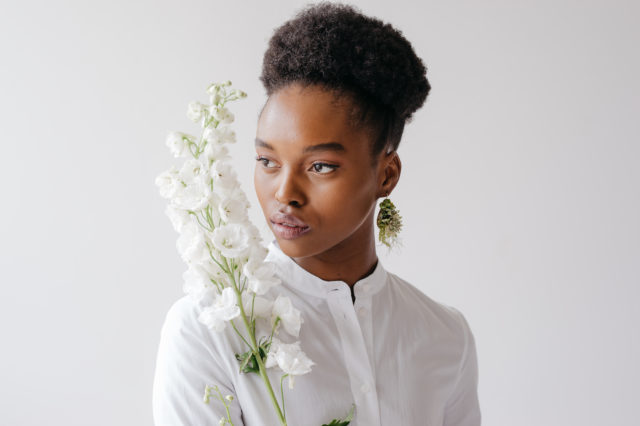 Erin: What are you currently working on, dreaming of, and excited about in your life and work?
Erin: What are you currently working on, dreaming of, and excited about in your life and work?
Susan: I’m doing a lot of daydreaming and making a bit of real progress on a new book idea. It will be an information-dense essential meant for designers and growers alike. I’m also working on some product development. If all goes well, an announcement of my new wearable mechanics line will happen in April. You’ll be the first to know!
Erin: Anything else you’d like to share?
Susan: I have to add that in addition to the online classes I run, I recently released the Virtual Studio. This is an affordable monthly subscription that delivers new tutorials and live master sessions each month, along with an interactive forum meant for sharing innovations, ideas, and progress. The classes offer specific design solutions, foundational skills, and methods for pivoting to sustainable design practices. I’m really enjoying the interactive and ongoing format of this model, and the feedback from the student group is fueling my creative energy. I’m thrilled that I’m able to teach this way!
Erin: Thank you so much, Susan, for being here with us today, and congratulations on the release of your gorgeous book.
I’m so excited to give away 3 copies of Susan’s beautiful new book, The Art of Wearable Flowers. For a chance to win, please share which wearable flowers you’re most inspired to try. Winners will be announced on Friday, March 6th.
UPDATE: A big congratulations to our winners Lola Higgins, Michelle Vara and Carolyn Hunter
Please note: If you submit a comment and it doesn’t show up right away, sit tight; we have a spam filter that requires we approve most comments before they are published.
Learn more and connect with Susan McLeary
Book: The Art of Wearable Flowers (Chronicle, March 2020); click here for a pre-order bonus.
Website: susanmcleary.com
Instagram: @passionflowersue
Photos from The Art of Wearable Flowers (Chronicle Books, 2020). Copyright © 2020. Photographs by Amanda Dumouchelle.

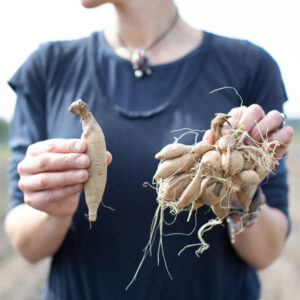

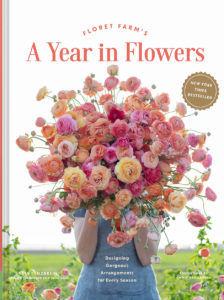
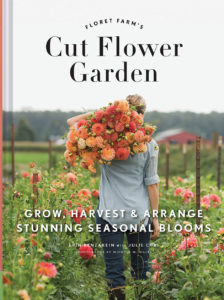


Viv Herman on
LOVE THE WIG!!!!!!!! ALSO THE NECKLACE–WOWZA…